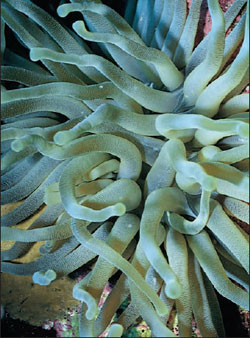Radiate Animals
 |
| Tentacles of a Caribbean sea anemone, Condylactis gigantea |
Although members of the phylum Cnidaria are more highly organized than sponges, they are still relatively simple animals. Most are sessile; those that are unattached, such as jellyfish, can swim only feebly. None can chase their prey. Indeed, we might easily get the false impression that the cnidarians were placed on earth to provide easy meals for other animals. The truth is, however, many cnidarians are very effective predators that are able to kill and eat prey that are much more highly organized, swift, and intelligent. They manage these feats because they possess tentacles that bristle with tiny, remarkably sophisticated weapons called nematocysts.
As it is secreted within the cell that contains it, the nematocyst is endowed with potential energy to power its discharge. It is as though a factory manufactured a gun, cocked and ready with a bullet in its chamber, as it rolls off the assembly line. Like a cocked gun, a completed nematocyst requires only a small stimulus to make it fire. Rather than a bullet, a tiny thread bursts from a nematocyst. Achieving a velocity of 2 meters/sec and an acceleration of 40,000 × gravity, it instantly penetrates its prey and injects a paralyzing toxin. A small animal unlucky enough to brush against one of the tentacles is suddenly speared with hundreds or even thousands of nematocysts and quickly immobilized. Some nematocyst threads can penetrate human skin, resulting in sensations ranging from minor irritation to great pain, even death, depending on the species. A fearsome, but wondrous, tiny weapon.
Position in Animal Kingdom
The two phyla Cnidaria and Ctenophora make up the radiate animals, which are characterized by primary radial or biradial symmetry, which we believe is ancestral for eumetazoans. Radial symmetry, in which the body parts are arranged concentrically around the oralaboral axis, is particularly suitable for sessile or sedentary animals and for freefloating animals because they approach their environment (or it approaches them) from all sides equally. Biradial symmetry is basically a type of radial symmetry in which only two planes through the oral-aboral axis divide the animal into mirror images because of the presence of some part that is single or paired. All other eumetazoans have a primary bilateral symmetry; they are bilateral or were derived from an ancestor that was bilateral.
Neither phylum has advanced generally beyond the tissue level of organization, although a few organs occur. In general, ctenophores are structurally more complex than cnidarians.
Biological Contributions
- Both phyla have developed two welldefined germ layers, ectoderm and endoderm; a third, or mesodermal, layer, which is derived embryologically from the ectoderm, is present in some. The body plan is saclike, and the body wall is composed of two distinct layers, epidermis and gastrodermis, derived from the ectoderm and endoderm, respectively. A gelatinous matrix, mesoglea, between these layers may be structureless, may contain a few cells and fibers, or may be composed largely of mesodermal connective tissue and muscle fibers.
- An internal body cavity, the gastrovascular cavity, is lined by gastrodermis and has a single opening, the mouth, which also serves as an anus.
- Extracellular digestion occurs in the gastrovascular cavity, and intracellular digestion takes place in the gastrodermal cells. Extracellular digestion allows ingestion of larger food particles.
- Most radiates have tentacles, or extensible projections around the oral end, that aid in food capture.
- Radiates are the simplest animals to possess true nerve cells (protoneurons), but the nerves are arranged as a nerve net, with no central nervous system.
- Radiates are the simplest animals to possess sense organs, which include well-developed statocysts (organs of equilibrium) and ocelli (photosensitive organs).
- Locomotion in free-moving forms is achieved either by muscular contractions (cnidarians) or ciliary comb plates (ctenophores). However, both groups are still better adapted to floating or being carried by currents than to strong swimming.
- Polymorphism* in cnidarians has widened their ecological possibilities. In many species the presence of both a polyp (sessile and attached) stage and a medusa (free-swimming) stage permits occupation of a benthic (bottom) and a pelagic (open-water) habitat by the same species. Polymorphism also widens the possibilities of structural complexity.
- Some unique features are found in these phyla, such as nematocysts(stinging organelles) in cnidarians and colloblasts (adhesive organelles) and ciliary comb plates in ctenophores.




